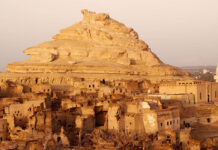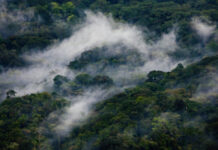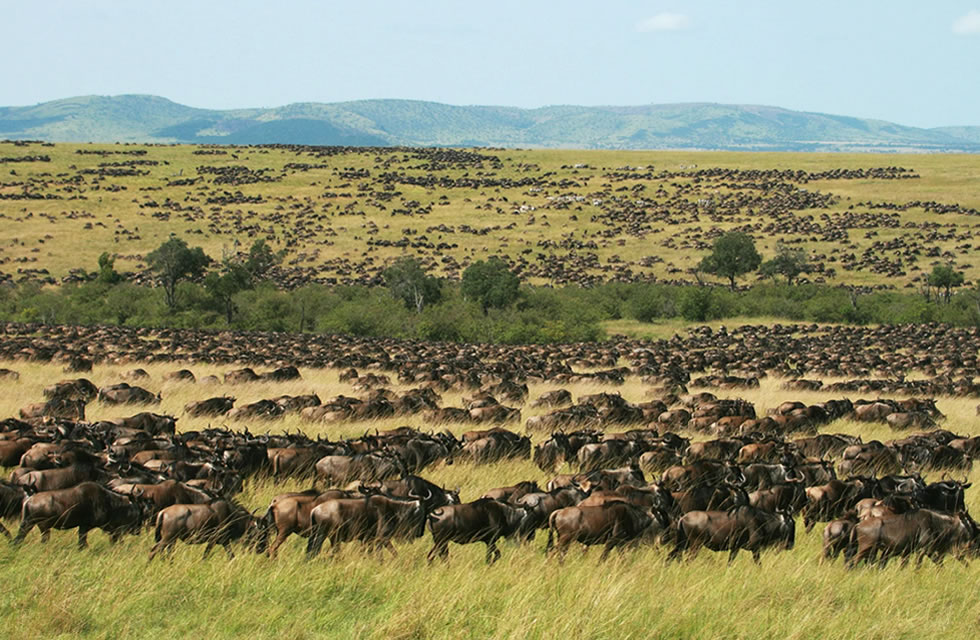Combining the Northern Serengeti with the Masai Mara literally gives you the best of both worlds. The combination allows you to witness the Great Migration from two different perspectives and also maximizes your opportunity to spend time with the migratory herds.
Each year, millions of wildebeest and plains game journey in a circular route from the north of the Serengeti in Tanzania to the south of Kenya’s Masai Mara. Considered the most spectacular of Africa’s natural phenomena, the wildebeest are driven by pure instinct, making this the greatest natural show on earth.
In the flocks of herbivores, you can find gazelles, zebras, and wildebeest. They are also accompanied by carnivores that stalk the herds as they move from grasslands to wooden forests. This epic journey crosses thousands of kilometres in an endless cycle.
One of the most frequent questions we receive is which country the great migration is the best place to experience this phenomenon. This is not a black or white answer, rather something that will be determined by examining a few similarities and differences between the Serengeti and Masai Mara.
The Serengeti National Park and Maasai Mara National Reserve are together arguably the greatest wildlife conservation areas in the world, home not just too numerous wildlife species, flora and fauna but also the site of one of the largest wildlife migratory movements on earth, the Great Wildebeest migration.
Masai Mara National Park
Masai Mara and locally known simply as the Mara, is a large national game reserve in Narok, Kenya, contiguous with the Serengeti National Park in Tanzania. It is named in honor of the Maasai people, the ancestral inhabitants of the area, who migrated to the area from the Nile Basin. Their description of the area when looked at from afar: “Mara” means “spotted” in the local Maasai language, due to the many short bushy trees which dot the landscape.
Maasai Mara is one of the most famous and important wildlife conservation and wilderness areas in Africa, world-renowned for its exceptional populations of lion, African leopard, cheetah and African bush elephant. It also hosts the Great Migration, which secured it as one of the Seven Natural Wonders of Africa, and as one of the ten Wonders of the World.
Things to do in the Masai Mara
The wildlife is the star attraction of the Masai Mara, and there are plenty of wonderful ways to see them. You can also enrich your Masai Mara safari by getting to know the Maasai, the traditional owners of the land.
Game drives
Game drives are the classic safari activity, and in the Masai Mara, you can experience both day and night game drives. During the day, you’ll head out early in the morning or late in the afternoon to spot the Mara’s iconic wildlife. On a night game drive, you’ll be treated to thrilling scenes of night time prowling and hunting, as many predators, especially big cats, only really come alive after dark.
Bush walks
A bush walk allows you to leave the vehicle behind and explore the Mara wilderness on foot. You’ll delve into the finer details of the African bush, with your guide pointing out plants and birds that you might not see from a vehicle. A walking safari is an exhilarating experience, and you can even spot big game and learn tracking skills from the experts.
Hot air balloon experience
Take to the skies in a hot air balloon at sunrise, to get a birds-eye view of the Masai Mara. You’ll have the best seat in the house, with panoramic views over the glowing plains, and the chance to spot wildlife at one of their most active times of the day. To end the experience, you’ll be treated to a lavish champagne breakfast in the bush.
Cultural experiences
The Maasai people own the land of the Masai Mara, and practice the traditional herding of Maasai cattle. You can get a special insight into the rich culture of the Maasai tribes, through visits to local villages, and traditional song and dance performances by Maasai warriors. You can also go on bush walks with the welcoming Maasai people, listening to their stories and wisdom about this beautiful land.
Best time to visit the Masai Mara national park
With plenty of resident wildlife and pleasant temperatures year round, the Masai Mara can be visited any time of the year. The most popular time to visit is July and August, when visitors flock to the country to witness the Great Migration.
If you’d like to see the Great Migration without the large crowds, consider visiting in October and November, when the wildebeest migrate back to the Serengeti. The timing of the return migration varies each year, as the wildebeest move with the arrival of the rainy season.
Kenya has two rainy seasons – a ‘short’ and ‘long’ wet season. The short rains generally arrive in November, characterized by brief, afternoon downpours that wash away the dust and cool down the humid air.
It’s a beautiful time for wildlife photography as the landscape lights up in greenery, migrant birds arrive, and baby antelope are born.
February and March are also stunning months to travel, with lush green grasslands and baby animals leaping around the plains. However, wildlife can be harder to spot after the rains, as the tall vegetation hides them from view.
The heavy rainy season usually lasts through April and May, with many lodges and camps closing during these months as the constant rains cause flooding and impassable muddy roads.
How to get to the Masai Mara
The easiest way to get to the Masai Mara is through Nairobi, Kenya’s capital city, located 224 kilometres from the eastern border of the Masai Mara.
You’ll land at the Jomo Kenyatta International Airport in Nairobi, then transfer to the nearby Wilson Airport for your domestic flight to the Masai Mara’s airstrips.
The flights take around 45 minutes, and on arrival you’ll be met your driver and transferred to your lodge or camp, keeping your eyes peeled for wildlife along the way.
Serengeti National Park
Serengeti is probably one of the most well-known safari destinations in Africa. It has been awarded the best national parks in the world multiple times and it is known to be the place to witness the greatest wildlife show on earth, the Great Wildebeest Migration.
With more than a million animals living on this virgin savanna covering more than 15,000,000 hectares (37,000,000 acres) across the northwestern part of Tanzania, there is no better place to go on a safari than here.
Things to do in Serengeti National Park
Wildlife watching
Serengeti national park provides the best wildlife viewing in the world making it one of the Top Things to do in Serengeti there are numerous animals to be seen its plains including Africa’s big five. There are various options for wildlife viewing you can either use a car or use an hot air balloon for a thrilling experience.
Visit the Retina hippo pool
The magnificent hippo pool harbors hundreds of hippopotamuses, though hippos can be found all over Serengeti national park, the best place for viewing them is at the Hippo pool. In the pool are also a good number of crocodiles to be seen.
Watch the great world migration
One of the main tourists attractions in Serengeti national park is the wildebeests migration. Wildebeest migration is the key and Top Things to do in Serengeti. Watching over a million animals moving in herds in the wild with predators on the follow up is one of the best things you should encounter before you die.
Visit Olduvai George
Olduvai George is where the remains of one of the worlds oldest human remains was excavated, the site is found in between the Ngorongoro crater and Serengeti national park. You can walk in the 300 mile long gorge and walk in the same footsteps of the earliest humans in earth. You can also visit Olduvai museum and get a lot of information about Olduvai George.
Visit the people
The Serengeti national park was earlier on dominated the nomadic Masai pastoralists who used to graze on the Serengeti plains, they have very unique ways of live, customs and cultural believes. You can take part of the Masai daily live by join in the grazing cows, milking and so forth for an African typical cultural experience as Top Things to do in Serengeti
Explore the Seronera river
His mighty rover is found in the central part of the Serengeti region, there are also lots of animals to see at the river banks such as; elephants, zebras, gazelles, lions and wildebeests among the rest. The endless valley also offers various accommodation units.
Wander to the Grumeti River
The Grumeti river is found in the western side of the park and is endowed with numerous crocodiles, the great wildebeests migration passes here when moving to Masai Mara and the crocodiles are at standby point waiting for dinner. The experience is so dramatic as you watch them prey.
Explore the Moru Kopjes
The Moru Kopjes are wonderful rock formations the rocks systematically rise up in various parts of the Serengeti plains the commonly spotted animal here is Africa’s black rhino. Some rocks also contain the ancient Masai paintings you would love to explore.
Visit the Bologonja springs
This springs are also one of the best areas with animal concentration in Serengeti, you will be able to see various animals like giraffes, elephants, zebras, wildebeests, lions and some many more.
Birding
Serengeti national park also boasts with numerous bird life with over 475 species of bird some of which are migratory birds while other are endemic to this area, one of the best places for bird watching is in the Bologonja springs.
Best time to visit
There is no bad time to visit the Serengeti National Park as there is plenty of resident game that stay all year round and don’t follow the migration route.
The short rains usually fall around November and December and the long rains around March to May. The dry season is between June and October. Some camps close during the wet season as the roads become impassable.
Getting there
By car – Serengeti National Park is about 325 km from Arusha. The road passes Lake Manyara, goes through the Ngorongoro Conservation Area past Olduvai Gorge and takes approximately eight hours.
By air – Flights into Serengeti National Park can land at a number of airstrips, including Seronera or Grumeti. Daily scheduled flights from Arusha run throughout the high season. Charter flights are also available. Arusha is served by two airports. Arusha Domestic Airport has daily flights from numerous local destinations and Kilimanjaro International Airport has daily flights from local, African and international destinations.
















